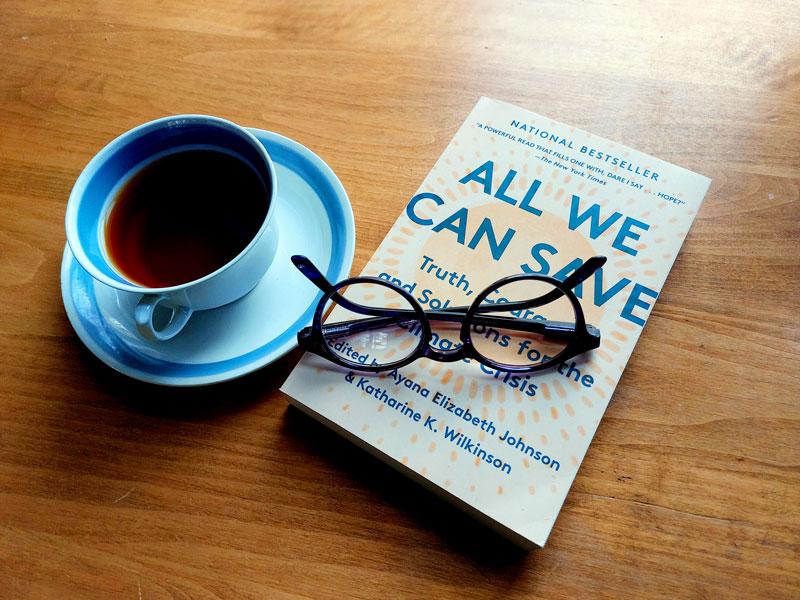Please enjoy this selection of books from Conservation Minnesota’s book club! Staff take turns choosing books that are relevant to our work, foster thoughtful discussion, and help us broaden our perspectives on climate change, environmental justice, and how we relate to the natural world and each other. We hope these titles are as enjoyable, inspiring, and thought-provoking for you as they have been for our team!
* indicates a Minnesota author
All We Can Save: Truth, Courage, and Solutions for the Climate Crisis
edited by Dr. Ayana Elizabeth Johnson and Dr. Katharine Wilkinson*
“All We Can Save illuminates the expertise and insights of dozens of diverse women leading on climate in the United States—scientists, journalists, farmers, lawyers, teachers, activists, innovators, wonks, and designers, across generations, geographies, and race. [...] These women offer a spectrum of ideas and insights for how we can rapidly, radically reshape society. [...] This book is both a balm and a guide for knowing and holding what has been done to the world, while bolstering our resolve never to give up on one another or our collective future.”
—Penguin Random House
The Seed Keeper
by Diane Wilson*
“A haunting novel spanning several generations set in southern Minnesota, The Seed Keeper follows a Dakota family’s struggle to preserve their way of life and their sacrifices to protect what matters most [...] Weaving together the voices of four indelible women, The Seed Keeper is a beautifully told story of reawakening, of remembering our original relationship to the seeds and, through them, to our ancestors.”
—Milkweed Editions
Onigamiising: Seasons of an Ojibwe Year
by Linda LeGarde Grover*
“Fifty short essays evoke the four seasons of the year, and of life, for the Ojibwe in northeastern Minnesota. [...] Grover reflects on the spiritual beliefs and everyday practices that carry the Ojibwe through the year and connect them to this northern land of rugged splendor.”
—University of Minnesota Press
The Climate Action Handbook
by Heidi Roop*
“The Climate Action Handbook shows us why we need to act now to combat climate change and then, critically, how—through easy-to-understand language and infographics that offer varied and doable solutions to the challenges facing our planet. [...] Dr. Heidi Roop shares 100 wide-ranging ways that readers from all walks of life can help move the needle in the right direction.”
—Penguin Random House
Climate Grief: From Coping to Resilience and Action
by Dr. Shawna Weaver*
“Climate change and climate grief are inseparable, and coping with the emotional fallout of the climate crisis is our first step toward dealing with the crisis itself and to building resilience.” This book invites the reader “to create a plan for building personal and planetary resilience. The planet can’t be healed by few people working out of despair but by many people working out of hope, care, and an openness to learn.”
—Lantern Publishing and Media
Braiding Sweetgrass
by Robin Wall Kimmerer
“Drawing on her life as an indigenous scientist, a mother, and a woman, Kimmerer shows how other living beings—asters and goldenrod, strawberries and squash, salamanders, algae, and sweetgrass—offer us gifts and lessons, even if we’ve forgotten how to hear their voices. [...] She circles toward a central argument: that the awakening of a wider ecological consciousness requires the acknowledgment and celebration of our reciprocal relationship with the rest of the living world.”
—Milkweed Editions
For Love of a River: The Minnesota
by Darby Nelson*
Special mention goes out to our former Board President Emeritus and Conservation Minnesota co-founder, Darby Nelson, and his lovingly researched and written work on the Minnesota River—just one of the ways in which his conservation legacy lives on.
“With an ecologist’s lens and a lifelong appreciation for wild and scenic places, Darby sets out with his wife, Geri, to paddle the river all the way from its source near the Minnesota-South Dakota border to its confluence with the Mississippi in the Twin Cities.”
—Beaver’s Pond Press / darbynelson.com

